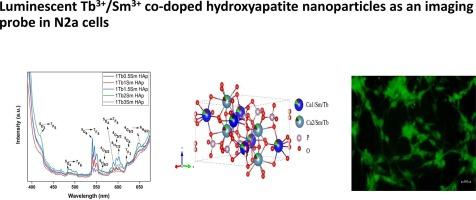Luminescent Tb3+/Sm3+ co-doped hydroxyapatite nanoparticles as an imaging probe in N2a cells
IF 4.3
2区 化学
Q1 SPECTROSCOPY
Spectrochimica Acta Part A: Molecular and Biomolecular Spectroscopy
Pub Date : 2024-11-12
DOI:10.1016/j.saa.2024.125334
引用次数: 0
Abstract
This work reports the synthesis of hydroxyapatite (HAp) nanoparticles co-doped with trivalent terbium (Tb3+) and samarium (Sm3+) ions by a surfactant free chemical precipitation method. Co-doping enables to combine the optical properties of Tb3+ and Sm3+ ions. Characterization techniques like X-Ray diffraction (XRD), transmission electron microscopy (TEM), Fourier transform infrared (FTIR) spectroscopy, inductively coupled plasma-optical emission spectroscopy (ICP-OES), energy dispersive X-ray spectroscopy (EDX) were used to determine the crystalline and structural properties. These studies confirmed that the lanthanide ions Tb3+ and Sm3+ were successfully doped onto the HAp lattice. The photoluminescence emission spectra exhibited intense emissions from both the lanthanide ions. The Sm3+ photoluminescence spectra showed enhanced emission, indicating that energy is being transferred from the Tb3+ to Sm3+ ions. To examine the cell viability, N2a cells were subjected to the MTT cytotoxicity assay. As demonstrated by the cell imaging on N2a cells, the synthesised nanoparticles are ideal candidates for fluorescent labelling using lanthanide ions. Furthermore, the strong cytocompatibility of Tb3+/Sm3+ co-doped hydroxyapatite suggests that it is a promising nanoscale biomaterial.

作为 N2a 细胞成像探针的发光 Tb3+/Sm3+ 共掺羟基磷灰石纳米粒子。
本研究报告采用无表面活性剂化学沉淀法合成了羟基磷灰石(HAp)纳米粒子,其中共同掺杂了三价铽(Tb3+)和钐(Sm3+)离子。共掺杂使 Tb3+ 和 Sm3+ 离子的光学特性得以结合。表征技术如 X 射线衍射 (XRD)、透射电子显微镜 (TEM)、傅立叶变换红外光谱 (FTIR)、电感耦合等离子体-光发射光谱 (ICP-OES)、能量色散 X 射线光谱 (EDX) 被用来确定晶体和结构特性。这些研究证实,镧系离子 Tb3+ 和 Sm3+ 已成功掺杂到 HAp 晶格中。光致发光发射光谱显示这两种镧系离子都有强烈的发射。Sm3+ 的光致发光光谱显示出更强的发射,表明能量正从 Tb3+ 转移到 Sm3+ 离子。为了检测细胞活力,对 N2a 细胞进行了 MTT 细胞毒性试验。N2a 细胞的细胞成像结果表明,合成的纳米粒子是使用镧系离子进行荧光标记的理想候选材料。此外,Tb3+/Sm3+共掺羟基磷灰石具有很强的细胞相容性,这表明它是一种很有前途的纳米级生物材料。
本文章由计算机程序翻译,如有差异,请以英文原文为准。
求助全文
约1分钟内获得全文
求助全文
来源期刊
CiteScore
8.40
自引率
11.40%
发文量
1364
审稿时长
40 days
期刊介绍:
Spectrochimica Acta, Part A: Molecular and Biomolecular Spectroscopy (SAA) is an interdisciplinary journal which spans from basic to applied aspects of optical spectroscopy in chemistry, medicine, biology, and materials science.
The journal publishes original scientific papers that feature high-quality spectroscopic data and analysis. From the broad range of optical spectroscopies, the emphasis is on electronic, vibrational or rotational spectra of molecules, rather than on spectroscopy based on magnetic moments.
Criteria for publication in SAA are novelty, uniqueness, and outstanding quality. Routine applications of spectroscopic techniques and computational methods are not appropriate.
Topics of particular interest of Spectrochimica Acta Part A include, but are not limited to:
Spectroscopy and dynamics of bioanalytical, biomedical, environmental, and atmospheric sciences,
Novel experimental techniques or instrumentation for molecular spectroscopy,
Novel theoretical and computational methods,
Novel applications in photochemistry and photobiology,
Novel interpretational approaches as well as advances in data analysis based on electronic or vibrational spectroscopy.

 求助内容:
求助内容: 应助结果提醒方式:
应助结果提醒方式:


